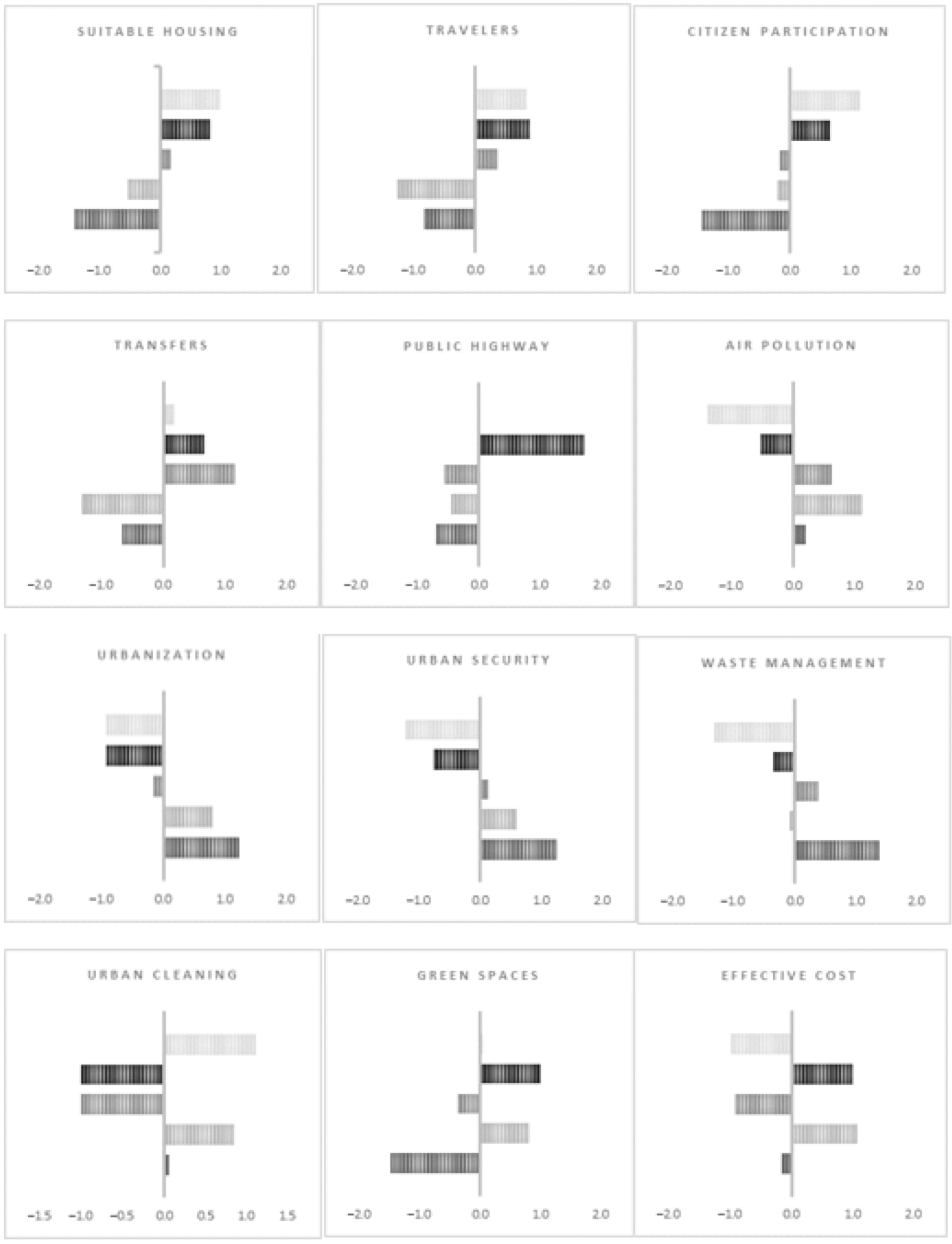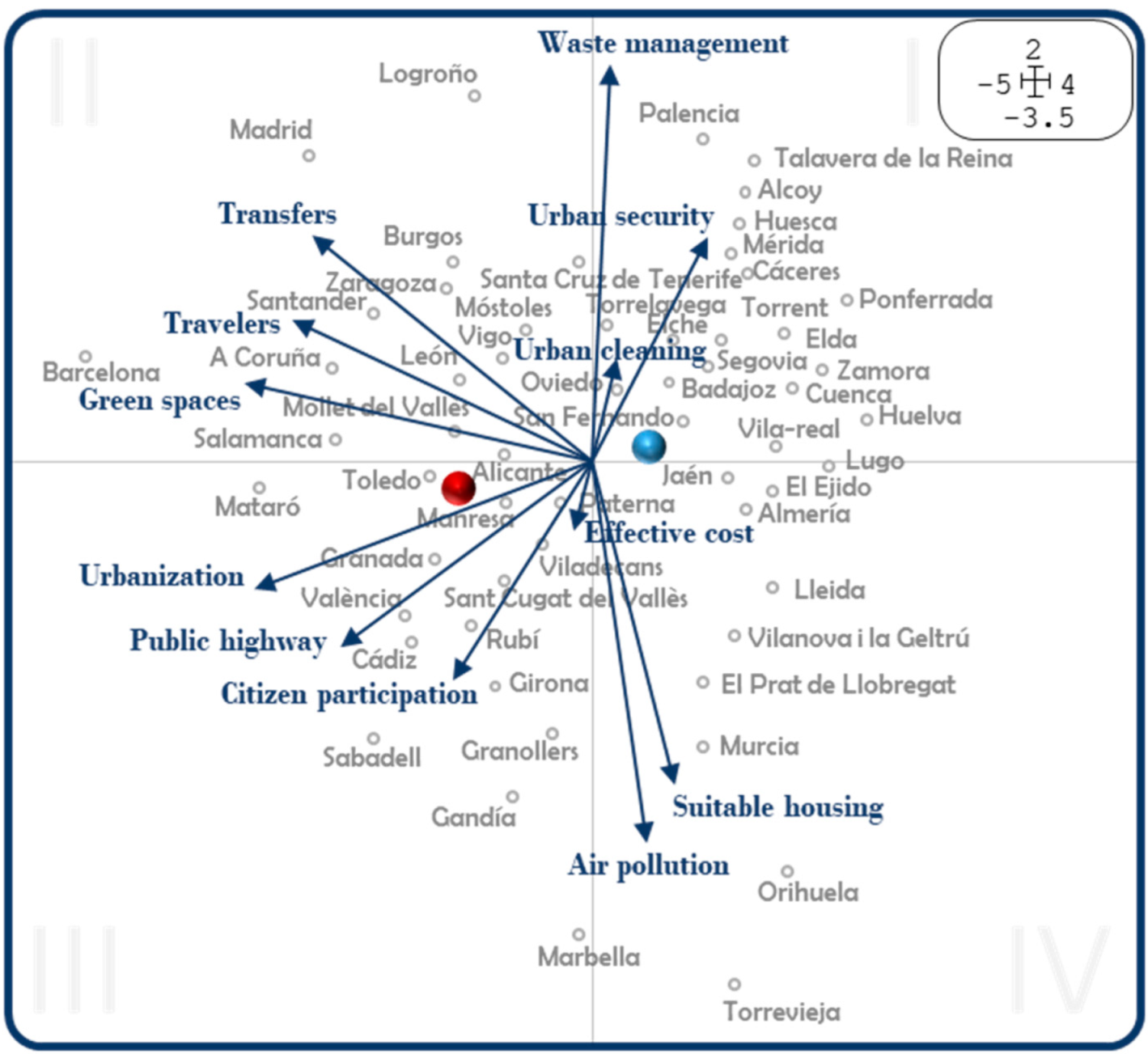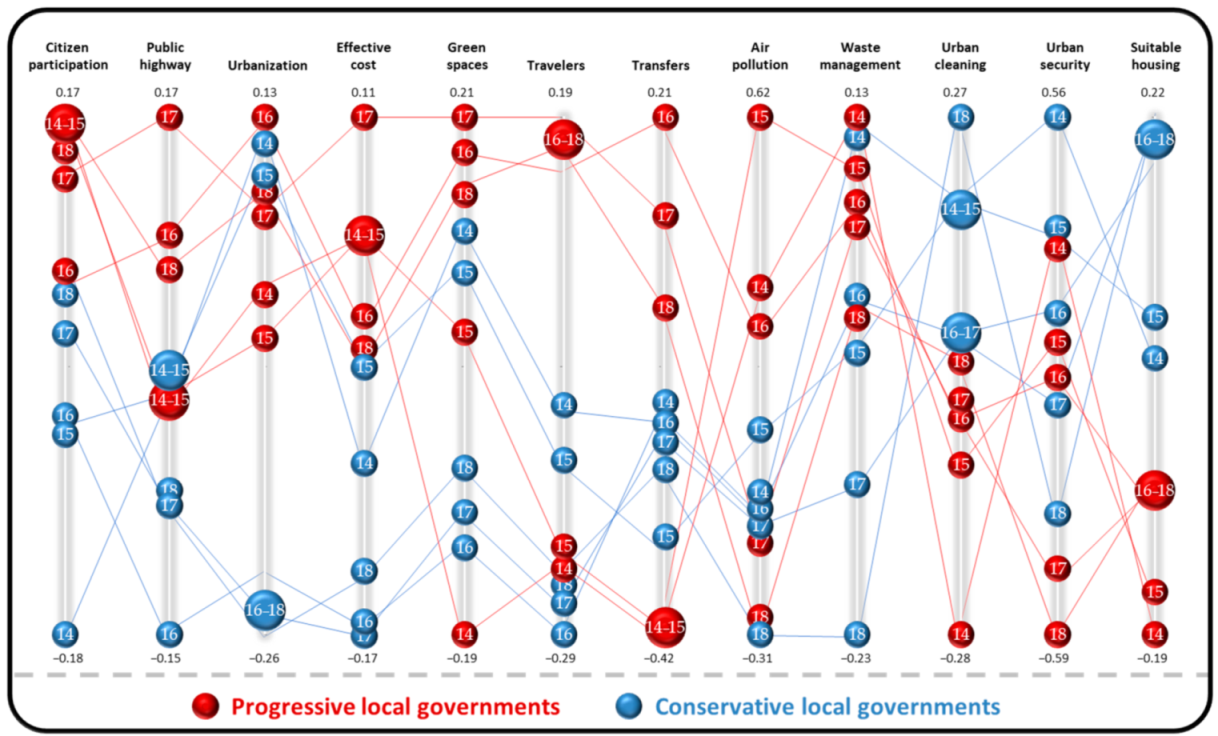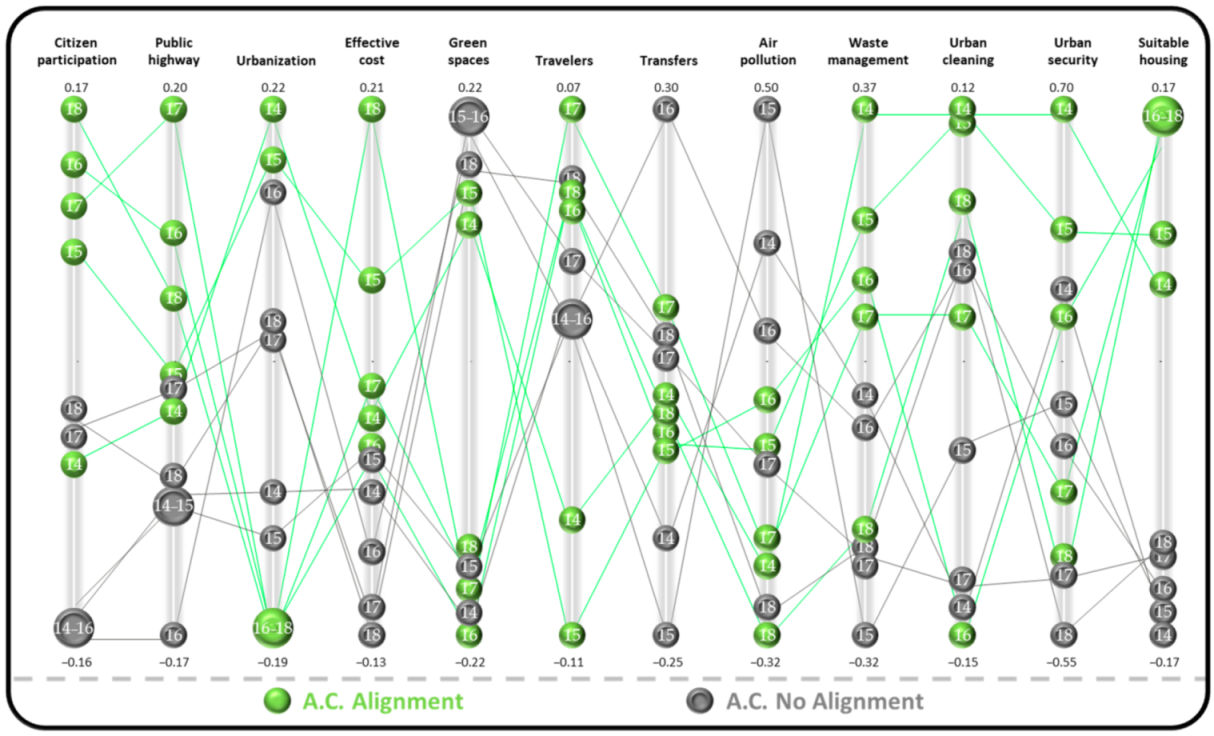The Commitment of Spanish Local Governments to Sustainable Development Goal 11 from a Multivariate Perspective
Abstract
1. Introduction
1.1. Benchmark Studies
1.2. Political Factors
2. Materials and Methods
2.1. Sample
2.2. Materials
2.3. Method
3. Results and Discussion
4. Conclusions
Author Contributions
Funding
Institutional Review Board Statement
Informed Consent Statement
Data Availability Statement
Acknowledgments
Conflicts of Interest
References
- Sustainable Development Report. 2020. Available online: https://sdgindex.org/reports/sustainable-development-report-2020/ (accessed on 17 November 2020).
- Guha, J.; Chakrabarti, B. Achieving the Sustainable Development Goals (SDGs) through decentralisation and the role of local governments: A systematic review. Commonw. J. Local Gov. 2019, 6855. Available online: https://orcid.org/0000-0002-5627-1462 (accessed on 17 November 2020). [CrossRef]
- Naim, K.; Beaudet, S. Network Governance for Collective Action in Implementing United Nations Sustainable Development Goals. Adm. Sci. 2020, 10, 100. [Google Scholar] [CrossRef]
- Rozhenkova, V.; Allmang, S.; Ly, S.; Franken, D.; Heymann, J. The role of comparative city policy data in assessing progress toward the urban SDG targets. Cities 2019, 95, 102357. [Google Scholar] [CrossRef]
- Hansson, S.; Arfvidsson, H.; Simon, D. Governance for sustainable urban development: The double function of SDG indicators. Area Dev. Policy 2019, 4, 217–235. [Google Scholar] [CrossRef]
- Xu, X.; Gao, J.; Zhang, Z.; Fu, J. An Assessment of Chinese Pathways to Implement the UN Sustainable Development Goal-11 (SDG-11)—A Case Study of the Yangtze River Delta Urban Agglomeration. Int. J. Environ. Res. Public Heal. 2019, 16, 2288. [Google Scholar] [CrossRef] [PubMed]
- Koch, F.; Krellenberg, K. How to contextualize SDG 11? Looking at indicators for sustainable urban development in Germany. ISPRS Int. J. Geo-Inf. 2018, 7, 464. [Google Scholar] [CrossRef]
- Firoiu, D.; Ionescu, G.H.; Băndoi, A.; Florea, N.M.; Jianu, E. Achieving sustainable development goals (SDG): Implementation of the 2030 Agenda in Romania. Sustainability 2019, 11, 2156. [Google Scholar] [CrossRef]
- Melchiorri, M.; Pesaresi, M.; Florczyk, A.J.; Corbane, C.; Kemper, T. Principles and applications of the global human settlement layer as baseline for the land use efficiency indicator—SDG 11.3. 1. ISPRS Int. J. Geo-Inf. 2019, 8, 96. [Google Scholar] [CrossRef]
- Mudau, N.; Mwaniki, D.; Tsoeleng, L.; Mashalane, M.; Beguy, D.; Ndugwa, R. Assessment of SDG Indicator 11.3. 1 and Urban Growth Trends of Major and Small Cities in South Africa. Sustainability 2020, 12, 7063. [Google Scholar] [CrossRef]
- Zhu, J.; Cao, Y.; Zhai, J.; Zhao, X.; Zhao, Y.; Kang, S. Analysis on synergies and trade-offs in green building development: From the perspective of SDG 11. Chin. J. Popul. Resour. Environ. 2019, 17, 341–351. [Google Scholar] [CrossRef]
- Navarro-Galera, A.; Lara-Rubio, J.; Buendía-Carrillo, D.; Rayo-Cantón, S. Analyzing Political and Systemic Determinants of Financial Risk in Local Governments. Transylv. Rev. Adm. Sci. 2020, 16, 104–123. [Google Scholar] [CrossRef]
- Alonso, J.M.; Andrews, R.; Hodgkinson, I.R. Institutional, ideological and political influences on local government contracting: Evidence from England. Public Adm. 2015, 94, 244–262. [Google Scholar] [CrossRef]
- Benito, B.; Guillamón, M.-D.; Martínez-Córdoba, P.-J. Determinants of efficiency improvement in the Spanish public lighting sector. Util. Policy 2020, 64, 101026. [Google Scholar] [CrossRef]
- Rios, V.; Pascual, E.; Cabases, F. What drives local government spending in Spain? A dynamic spatial panel approach. Spat. Econ. Anal. 2017, 12, 230–250. [Google Scholar] [CrossRef]
- Bolívar, M.P.R.; Navarro-Galera, A.; Subirés, M.D.L.; Muñoz, L.A. Analysing the accounting measurement of financial sustainability in local governments through political factors. Account. Audit. Account. J. 2018, 31, 2135–2164. [Google Scholar] [CrossRef]
- Benito, B.; Martínez-Córdoba, P.-J.; Guillamón, M.-D. Impact of politicians’ salaries and their dedication regime on the efficiency of municipal public services. Local Gov. Stud. 2020, 1–24. [Google Scholar] [CrossRef]
- Jaffrenou, P.A. Sur L’analyse des Familles Finies de Variables Vectorielles: Bases Algébriques et Application à la Description Statistique. Ph.D. Thesis, Université de Lyon, Lyon, France, 1978. [Google Scholar]
- Escoufier, Y. Opérateur associé à un tableau de données. In Annales de l’INSEE; JSTOR: New York, NY, USA, 1976; pp. 165–179. [Google Scholar]
- L’Hermier des Plantes, H. Structuration des Tableauya trois Indices de la Statistique; Université Montpellier II: Montpellier, France, 1976. [Google Scholar]
- Thioulouse, J.; Chessel, D.; Dole, S.; Olivier, J.-M. ADE-4: A multivariate analysis and graphical display software. Stat. Comput. 1997, 7, 75–83. [Google Scholar] [CrossRef]
- Inselberg, A. The Plane R2 with Coordinate Parallel. In Computer Science and Applied Mathematics Departments; Tel Aviv University: Tel Aviv, Israel, 1992. [Google Scholar]
- Martínez-Córdoba, P.J.; Raimo, N.; Vitolla, F.; Benito, B. Achieving Sustainable Development Goals. Efficiency in the Spanish Clean Water and Sanitation Sector. Sustainability 2020, 12, 3015. [Google Scholar] [CrossRef]







| Targets 1 | Indicators 1 | Outputs 2 |
|---|---|---|
| By 2030, ensure access for all to adequate, safe, and affordable housing and basic services and upgrade slums. | Proportion of urban population living in slums, informal settlements, or inadequate housing. | Suitable housing |
| By 2030, provide access to safe, affordable, accessible, and sustainable transport systems for all, improving road safety, notably by expanding public transport, with special attention to the needs of those in vulnerable situations, women, children, persons with disabilities, and older persons. | Proportion of population that has convenient access to public transport, by sex, age, and persons with disabilities. | Travelers |
| By 2030, enhance inclusive and sustainable urbanisation and capacity for participatory, integrated, and sustainable human settlement planning and management in all countries. | Ratio of land consumption rate to population growth rate. | Urbanisation |
| Proportion of cities with a direct participation structure of civil society in urban planning and management that operate regularly and democratically. | Citizen participation | |
| Strengthen efforts to protect and safeguard the world’s cultural and natural heritage. | Total expenditure (public and private) per capita spent on the preservation, protection, and conservation of all cultural and natural heritage, by type of heritage (cultural, natural, mixed and World Heritage Centre designation), level of government (national, regional, and local/municipal), type of expenditure (operating expenditure/investment), and type of private funding (donations in kind, private non-profit sector, and sponsorship). | Effective cost |
| By 2030, significantly reduce the number of deaths and the number of people affected and substantially decrease the direct economic losses relative to global gross domestic product caused by disasters, including water-related disasters, with a focus on protecting the poor and people in vulnerable situations. | Number of deaths, missing persons and persons affected by disaster per 100,000 people. | During the years analysed, no relevant events have occurred in the municipalities in the sample. |
| Direct disaster economic loss in relation to global GDP, including disaster damage to critical infrastructure and disruption of basic services. | During the years analysed, no relevant events have occurred in the municipalities in the sample. | |
| By 2030, reduce the adverse per capita environmental impact of cities, including by paying special attention to air quality and municipal and other waste management. | Proportion of urban solid waste regularly collected and with adequate final discharge out of total urban solid waste generated, by cities. | Urban cleaning Waste management |
| Annual mean levels of fine particulate matter (e.g., PM2.5 and PM10) in cities (population weighted). | Air pollution | |
| By 2030, provide universal access to safe, inclusive and accessible, green, and public spaces, in particular for women and children, older persons, and persons with disabilities. | Average share of the built-up area of cities that is open space for public use for all, by sex, age, and persons with disabilities. | Green spaces Public highway |
| Proportion of persons who were a victim of physical or sexual harassment, by sex, age, disability status, and place of occurrence, in the previous 12 months. | Urban security | |
| Support positive economic, social, and environmental links between urban, peri-urban, and rural areas by strengthening national and regional development planning. | Proportion of population living in cities that implement urban and regional development plans integrating population projections and resource needs, by size of city. | All the municipalities in the sample prepare these projects. |
| By 2020, substantially increase the number of cities and human settlements adopting and implementing integrated policies and plans towards inclusion, resource efficiency, mitigation and adaptation to climate change, resilience to disasters, and develop and implement, in line with the Sendai Framework for Disaster Risk Reduction 2015–2030, holistic disaster risk management at all levels. | Proportion of local governments that adopt and implement local disaster risk reduction strategies in line with the Sendai Framework for Disaster Risk Reduction 2015–2030. | All the municipalities in the sample prepare these projects. |
| Number of countries with national and local disaster risk reduction strategies. | All the municipalities in the sample prepare these projects. | |
| Support least developed countries, including through financial and technical assistance, in building sustainable and resilient buildings utilising local materials. | Proportion of financial support to the least developed countries that is allocated to the construction and retrofitting of sustainable, resilient and resource-efficient buildings utilising local materials. | Transfers |
| Outputs | Description | Minimum | Mean | Median | Maximum | Deviation |
|---|---|---|---|---|---|---|
| Suitable housing | Number of residential properties per capita in the municipality a | 0.356 | 0.520 | 0.487 | 1.467 | 0.155 |
| Travelers | Annual per capita number of passengers in the municipality’s urban public transport b | 0.315 | 40.465 | 28.937 | 140.703 | 37.179 |
| Urbanisation | Urbanised area between the total area of the municipality in km2 a | 0.008 | 0.208 | 0.185 | 0.584 | 0.144 |
| Citizen participation | Euros per capita of the budget settlement for citizen participation c | 0.018 | 5.296 | 2.782 | 31.832 | 6.576 |
| Effective cost | Euros per capita of the effective cost of the service of protection and management of historical heritage b | 0.012 | 2.593 | 1.770 | 21.100 | 3.068 |
| Urban cleaning | Periodicity in the collection of solid urban waste. Take values from 1 (sporadic collection) to 6 (daily collection) b | 1.000 | 5.610 | 6.000 | 6.000 | 1.178 |
| Waste management | Annual tons of municipal solid waste collected (applied the inverse, higher value implies better waste management) b | 1.396 | 2.485 | 2.490 | 3.321 | 0.367 |
| Air pollution | Air quality, average annual levels of fine particles (sum of PM2.5 and PM10) in municipalities d | 2.528 | 25.856 | 25.390 | 74.444 | 12.354 |
| Green spaces | Area in square kilometres of parks and gardens in the municipality divided by the total area of the municipality e | 0.015 | 0.047 | 0.031 | 0.187 | 0.038 |
| Public highway | Area in square kilometres of the paved sections of the municipality divided by the total area of the municipality e | 0.016 | 0.072 | 0.059 | 0.203 | 0.046 |
| Urban security | Universal access to safe green and public spaces. Inverse of crime data (crimes against freedom and sexual indemnity) per capita (higher value, higher security of the municipality) f | 1364.787 | 4554.363 | 3965.591 | 17817.333 | 2309.061 |
| Transfers | Amount in euros per capita of current and capital transfers abroad from the budget settlement c | 0.023 | 0.787 | 0.260 | 3.112 | 0.908 |
| Ideology | Ideology of the local government leader. Dummy variable, which takes the value 0 if it is left and 1 if it is right g | 0.000 | 0.538 | 1.000 | 1.000 | 0.499 |
| Ideological alignment | Ideological coincidence with the government of the corresponding Autonomous Community. Dummy variable that takes the value 1 if it matches and 0 otherwise g | 0.000 | 0.521 | 1.000 | 1.000 | 0.500 |
| Citizen Participation | Public Highway | Urbanization | Effective Cost | Green Spaces | Travelers | Transfers | Air Pollution | Waste Management | Urban Cleaning | Urban Security | Suitable Housing | |
|---|---|---|---|---|---|---|---|---|---|---|---|---|
| U de Mann–Whitney | 8222 | 9399.5 | 9703 | 9843 | 8816 | 10,072 | 9294.5 | 9397 | 10,157 | 9690.5 | 7727 | 7557 |
| W de Wilcoxon | 20,468 | 21,645.5 | 21,949 | 22,089 | 21,062 | 22,318 | 21,540.5 | 21,643 | 22,403 | 18,735.5 | 16,772 | 16,602 |
| Z | −3.132 | −1.478 | −1.052 | −0.87 | −2.298 | −0.534 | −1.976 | −1.482 | −0.414 | −1.915 | −3.827 | −4.066 |
| Sig. Asintótica (bilateral) | 0.002 | 0.139 | 0.293 | 0.384 | 0.022 | 0.594 | 0.048 | 0.138 | 0.679 | 0.045 | 0.000 | 0.000 |
| Citizen Participation | Public Highway | Urbanization | Effective Cost | Green Spaces | Travelers | Transfers | Air Pollution | Waste Management | Urban Cleaning | Urban Security | Suitable Housing | |
|---|---|---|---|---|---|---|---|---|---|---|---|---|
| U de Mann–Whitney | 10,477 | 9433.5 | 10,282 | 9676 | 10,206 | 10,017 | 9728.5 | 8979 | 8814 | 10,231.5 | 9078 | 7890 |
| W de Wilcoxon | 21,953 | 19,163.5 | 20,012 | 19,406 | 21,682 | 21,493 | 21,204.5 | 20,455 | 18,544 | 19,961.5 | 18,808 | 17,620 |
| Z | −0.025 | −1.487 | −0.298 | −1.167 | −0.404 | −0.669 | −1.305 | −2.124 | −2.356 | −0.66 | −1.985 | −3.651 |
| Sig. Asintótica (bilateral) | 0.980 | 0.137 | 0.766 | 0.243 | 0.686 | 0.503 | 0.192 | 0.034 | 0.018 | 0.509 | 0.047 | 0.000 |
Publisher’s Note: MDPI stays neutral with regard to jurisdictional claims in published maps and institutional affiliations. |
© 2021 by the authors. Licensee MDPI, Basel, Switzerland. This article is an open access article distributed under the terms and conditions of the Creative Commons Attribution (CC BY) license (http://creativecommons.org/licenses/by/4.0/).
Share and Cite
Martínez-Córdoba, P.-J.; Amor-Esteban, V.; Benito, B.; García-Sánchez, I.-M. The Commitment of Spanish Local Governments to Sustainable Development Goal 11 from a Multivariate Perspective. Sustainability 2021, 13, 1222. https://doi.org/10.3390/su13031222
Martínez-Córdoba P-J, Amor-Esteban V, Benito B, García-Sánchez I-M. The Commitment of Spanish Local Governments to Sustainable Development Goal 11 from a Multivariate Perspective. Sustainability. 2021; 13(3):1222. https://doi.org/10.3390/su13031222
Chicago/Turabian StyleMartínez-Córdoba, Pedro-José, Víctor Amor-Esteban, Bernardino Benito, and Isabel-María García-Sánchez. 2021. "The Commitment of Spanish Local Governments to Sustainable Development Goal 11 from a Multivariate Perspective" Sustainability 13, no. 3: 1222. https://doi.org/10.3390/su13031222
APA StyleMartínez-Córdoba, P.-J., Amor-Esteban, V., Benito, B., & García-Sánchez, I.-M. (2021). The Commitment of Spanish Local Governments to Sustainable Development Goal 11 from a Multivariate Perspective. Sustainability, 13(3), 1222. https://doi.org/10.3390/su13031222









